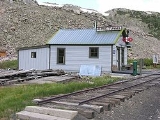
Denver, South Park and Pacific Railroad
Encyclopedia
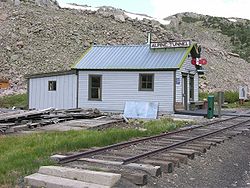
Colorado
Colorado is a U.S. state that encompasses much of the Rocky Mountains as well as the northeastern portion of the Colorado Plateau and the western edge of the Great Plains...
in the western United States
United States
The United States of America is a federal constitutional republic comprising fifty states and a federal district...
in the late 19th century. The railroad opened up the first rail routes to a large section of the central Colorado mining district
Colorado Mineral Belt
The Colorado Mineral Belt is an area with abundant ore deposits. The area stretches north-east from the La Plata Mountains in Southwestern Colorado to the Front Range near Boulder, Colorado...
in the decades of the mineral boom. The railroad took its name from the fact that its main line from Denver
Denver, Colorado
The City and County of Denver is the capital and the most populous city of the U.S. state of Colorado. Denver is a consolidated city-county, located in the South Platte River Valley on the western edge of the High Plains just east of the Front Range of the Rocky Mountains...
ascended the Platte Canyon
Platte Canyon
The Platte Canyon is a deep, narrow, scenic gorge on the South Platte River in the Rocky Mountains of Colorado. The canyon is southwest of Denver on the border between Jefferson and Douglas counties. The canyon is at the entrance to the mountains, where the South Platte emerges through the Rampart...
and traversed South Park
South Park (Colorado basin)
South Park is a high intermontane grassland basin, approximately 10,000 ft in elevation, in the Rocky Mountains of central Colorado. It encompasses approximately 1,000 square miles around the headwaters of the South Platte River in Park County approximately 60 mi southwest of Denver...
. The company operated as an independent railroad from its founding in 1872 until it was sold in foreclosure proceedings to the Denver Leadville & Gunnison RR in 1889.Its lines later became part of the Colorado and Southern Railway
Colorado and Southern Railway
The Colorado and Southern Railway was a railroad company in the western United States that operated independently from 1898 to 1908, then as part of the Chicago, Burlington and Quincy Railroad until it was absorbed into the Burlington Northern Railroad in 1981.The railway began as the...
. The last train to run the old DSP&P was from Como, Colorado on April 11th 1937. In the first half of the 20th century, nearly all the company's original lines were dismantled or converted into standard gauge. A section of the standard gauge line between Leadville
Leadville, Colorado
Leadville is a Statutory City that is the county seat of, and the only municipality in, Lake County, Colorado, United States. Situated at an elevation of , Leadville is the highest incorporated city and the second highest incorporated municipality in the United States...
and Climax
Climax, Colorado
Climax was an unincorporated mining village and a former U.S. Post Office located in Lake County, Colorado. Climax was known for its large molybdenum ore deposit. The former Climax Post Office had the ZIP Code 80429. Climax is located along the Continental Divide at an elevation of about 11,360 feet...
is operated as a passenger excursion railroad called the Leadville, Colorado and Southern Railroad.
Description of lines
The company's main line was gauge and went from Union StationUnion Station (Denver)
Union Station is Denver, Colorado, USA's historic train station at 17th and Wynkoop in the LoDo district. The station first opened in 1881.-History:...
in Denver up the valley of the South Platte River
South Platte River
The South Platte River is one of the two principal tributaries of the Platte River and itself a major river of the American Midwest and the American Southwest/Mountain West, located in the U.S. states of Colorado and Nebraska...
to the town of South Platte, then followed the North Fork of the South Platte through Buffalo Creek
Buffalo Creek, Colorado
Buffalo Creek is an unincorporated town and U.S. Post Office in Jefferson County, Colorado, United States. The ZIP Code of the Buffalo Creek Post Office is 80425.-History:The town of Buffalo Creek was established about 1877 along the stream of the same name...
and Bailey
Bailey, Colorado
Bailey is an unincorporated town and U.S. Post Office in northeastern Park County, Colorado, United States.The ZIP Code of the Bailey Post Office is 80421. Bailey is in the Mountain Time Zone. The community is located along U.S...
. West of Bailey the route along North Fork and through the north end of the Tarryall Mountains essentially followed the route of present-day U.S. Highway 285 to Como
Como, Colorado
Como is an unincorporated town and a U.S. Post Office in Park County, Colorado, United States. The Como Post Office has the ZIP Code 80432.Located at the northern end of South Park, the town is a historic mining settlement founded during the Pike's Peak Gold Rush in 1859. It sits approximately...
, where it branched northward (see below). From Como the main line transvered South Park to Garo
Garo, Colorado
Garo, Colorado is a former settlement in South Park in Colorado, in Park County. No one lives there currently. It is about 5 miles north of Hartsel and 7 miles south of Fairplay on Colorado Highway 9, at an elevation of . The community was named after its founder, Adolph Guiraud.-References:#...
, where a spur went northward to Fairplay
Fairplay, Colorado
The Town of Fairplay is a statutory town that is the county seat and the most populous town of Park County, Colorado, United States. Fairplay is located in South Park at an elevation of . The town is the fifth-highest incorporated place in the State of Colorado. The population was 610 at the...
and Alma
Alma, Colorado
The historic Town of Alma is a Statutory Town located in Park County, Colorado, United States. The town population was 179 at the U.S. Census 2000....
. The main line continued south over Trout Creek Pass
Trout Creek Pass
Trout Creek Pass is a mountain pass located in the Rocky Mountains of south-central Colorado in the United States. The pass sits atop the southern end of the Mosquito Range on the Park-Chaffee county line, between South Park and the headwaters of the Arkansas River to the west...
. On the western side of the pass, a small spur of the main connected to Buena Vista
Buena Vista, Colorado
Buena Vista is a Statutory Town in Chaffee County, Colorado, United States. The population was 2,195 at the 2000 census.Buena Vista is located in central Colorado roughly midway between Salida and Leadville in the Upper Arkansas River Valley at an elevation of . The area between Buena Vista and...
, then traversed the southern end of the Sawatch Range
Sawatch Range
The Sawatch Range is a mountain range in central Colorado which includes eight of the twenty highest peaks in the Rocky Mountains, including Mount Elbert, at elevation, the highest peak in the Rockies....
through the Alpine Tunnel
Alpine Tunnel
Alpine Tunnel is a narrow gauge railroad tunnel located east of Pitkin, Colorado on the former Denver, South Park and Pacific Railroad route from Denver to Gunnison. At an elevation of , it was the first tunnel constructed through the Colorado Continental Divide, and according to the U.S. Forest...
to Pitkin
Pitkin, Colorado
Pitkin is a Statutory Town in Gunnison County, Colorado, United States. The population was 66 at the 2010 census.-Geography:Pitkin is located at ....
and Gunnison
Gunnison
Gunnison may refer to:* John W. Gunnison , U.S. explorer whose name is used in several places in the Western states* The Gunnison River in Colorado** Black Canyon of the Gunnison National Park* Gunnison, Colorado* Gunnison County, Colorado...
. The distance along the main line from Denver to Gunnison was approximately 208 miles (334.7 km).
A principal branch of the main line north from Como went over Boreas Pass
Boreas Pass
Boreas Pass, elevation , is a high mountain pass in the Rocky Mountains of central Colorado in the United States. The pass is located on the continental divide, at the crest of the Front Range along the border between Park and Summit counties...
to Breckenridge
Breckenridge, Colorado
Established in 1859, the historic town of Breckenridge is a home rule municipality that is the county seat of Summit County, Colorado, United States. As of the 2010 Census, the town had a population of 4,540. The town also has many part-time residents, as many people have vacation homes in the area...
, Dillon
Dillon, Colorado
Dillon is a home rule municipality in Summit County, Colorado, United States. The population was 802 at the 2000 census.-Geography:Dillon is located at ....
, Keystone
Keystone, Colorado
Keystone is a census-designated place in Summit County, Colorado, United States. The population was 825 at the 2000 census. The Dillon Post Office serves Keystone postal addresses....
, Frisco
Frisco, Colorado
Frisco is a home rule municipality in Summit County, Colorado, United States. The population was 2,443 at the 2000 census. It is a popular town among skiers from around the world...
and Climax. This branch terminated at Leadville.
A small 7 miles (11.3 km) branch of the main line 9 miles (14.5 km) south of Denver connected to Morrison
Morrison, Colorado
The historic Town of Morrison is a Home Rule Municipality in Jefferson County, Colorado, United States. The population was 430 at the 2000 census...
(this line was actually constructed first).
History
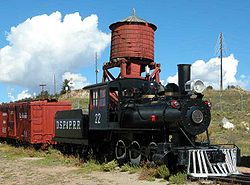
Colorado Territory
The Territory of Colorado was an organized incorporated territory of the United States that existed from February 28, 1861, until August 1, 1876, when it was admitted to the Union as the State of Colorado....
as the "Denver, South Park and Pacific Railway" on October 2, 1872 with 2.5 million dollars in capital. Less than a year later, on June 16, 1873, it was reorganized by John Evans
John Evans (governor)
John Evans was a U.S. politician, physician, railroad promoter, Governor of the Territory of Colorado, and namesake of Evanston, Illinois; Evans, Colorado; and Mount Evans, Colorado...
as the "Denver, South Park and Pacific Railroad" with an increased capitalization of 3.5 million dollars. Construction from Denver to Morrison began in August, 1873, by the Denver Railway Association, following approval by Arapaho County Voters who passed a $300,000 Bond Issue. On June 20, the tracks reached Morrison, and on July 3, scheduled service began between Denver and Morrison, with two 2 round-trip mixed trains per day. This branch would provide a healthy income from the start, shipping stone, lumber, and coal from Mt. Carbon. However, the financial panic in 1873
Panic of 1873
The Panic of 1873 triggered a severe international economic depression in both Europe and the United States that lasted until 1879, and even longer in some countries. The depression was known as the Great Depression until the 1930s, but is now known as the Long Depression...
, precipitated by Jay Cooke & Co
Jay Cooke & Company
Jay Cooke & Company was a U.S. bank from 1861 to 1873. It was the first brokerage house to use telegraph messages to confirm with clients the purchase and sale of securities. Headquartered in Philadelphia, Pennsylvania, it had branches in New York City and Washington, DC...
. of Philadelphia (financiers of the Northern Pacific Railroad), caused a reduction in traffic, resulting in reduced construction until 1876. During this period, the Denver, South Park and Pacific Railroad struggled to remain solvent.
The tracks reached the mouth of the Platte Canyon on May 4, 1878, 20 miles (32.2 km) from Denver, and by June 2, the tracks reached 12 miles (19.3 km) up the canyon. The tracks reached Buffalo Creek on June 17. The following year, on May 19, 1879, the tracks reached to the summit of Kenosha Pass
Kenosha Pass
Kenosha Pass, elevation , is a high mountain pass located in the Rocky Mountains of central Colorado in the United States.The pass is located in the Rocky Mountains southwest of Denver, Colorado, just northeast of the town of Fairplay, Colorado...
and on June 27 they reached Como. The railroad was earning about $1,200 a day, with only a daily operating expense of $480. This made the railroad very profitable, while also allowing a steady flow of money to help with construction cost. In November 1879, with the tracks only as far as South Park, the company contracted for the initial construction of the Alpine Tunnel, with an expected finish date of July 1, 1880. The following month, the tracks reached to the summit of Trout Creek Pass.
Leadville mining boom
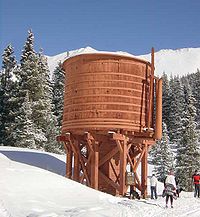
Denver and Rio Grande Western Railroad
Denver and Rio Grande Western Railroad
The Denver & Rio Grande Western Railroad , often shortened to Rio Grande or D&RGW, formerly the Denver & Rio Grande Railroad, is a defunct U.S. railroad company. The railroad started as a narrow gauge line running south from Denver, Colorado in 1870; however, served mainly as a transcontinental...
. Work began on the branch line ("High Line") to Leadville, and on July 2, 1880, the first train arrived in Leadville. Denver, South Park and Pacific completed construction first, but rather than both companies laying track to Leadville, Jay Gould pressured the two companies to make a deal called the "Joint Operation Agreement" of October 1, 1879. The companies agree that "...for the purpose of harmony and mutual profit...", the Denver and Rio Grande would lay tracks to the north from Buena Vista to the Leadville mining district, but that the Denver, South Park and Pacific would share equal traffic rights. Similarly, when Denver, South Park and Pacific were given rights to build into the Gunnison Country via Chalk Creek, equal traffic rights were given to the Denver and Rio Grande. Construction continued past Mount Princeton
Mount Princeton
Mount Princeton is one of the fourteeners of the US state of Colorado. It lies in the Collegiate Peaks, in the central part of the Sawatch Range, just west of the Arkansas River. While not one of the highest peaks of the Sawatch, it is one of the most dramatic, as it rises over 6,500 feet from the...
to what would become the Alpine Tunnel
The Alpine Tunnel
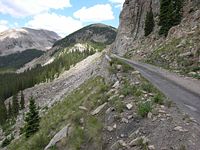
The line exited the west portal of the Alpine Tunnel, to Alpine Tunnel Station, the highest railroad station in the United States. There also was a turntable, water tank, and a two-story frame boarding house that replaced the stone boarding house and engine house, which burned down in 1906. Parlin, located at milepost 189.78 is where the tracks of the Denver, South Park and Pacific and the Denver and Rio Grande joined up and ran along each other to Gunnison. The land for the track was given to the railroad by local dairy rancher John Parlin around 1877, with the condition that the railroad would build a depot, and stop for at least five minutes so passengers could buy milk. The main line reached Gunnison the following year in 1882.
After reaching Gunnison
The Denver, South Park, & Pacific built north of Gunnison up the Ohio Creek Drainage to the Castelton and Baldwin Areas. Then planning to cross over Kebler Pass to Delta, Grand Junction, and points west and south. Track was laid four miles (6 km) past the Baldwin Mine, and another eight miles (13 km) were graded, but after losing right of ways to Lake City, and the San Juan Mining District, no more construction would be done west.The railroad went into receivership on in May 1888. On July 17, 1889, the company was sold at foreclosure proceedings to the Denver, Leadville and Gunnison Railway, a new railroad which was formed to operate the DSP&P lines. The successor company went into receivership on August 4, 1894. The Colorado and Southern, charted in 1898, took over the former DSP&P lines in January 1899. The Colorado and Southern started dismantling in 1910 with the closure of the Alpine Tunnel. In 1930, the C&S attempted to shut down the main line through the Platte Canyon, in cooperation with the Denver Board of Water Commissioners, who desired to build a dam in the canyon (the dam was never built). Nevertheless, the construction of modern roads in the Rockies led to a decrease in revenue and traffic. The last freight and passenger trains between Denver and Leadville operated in April 1937, and on April 10, 1937, the South Park Line officially closed down. The last regular freight train operated between Denver and Como on April 25. The last narrow gauge section, between Leadville and Climax, was converted to standard gauge on August 25, 1943.
Remaining Locomotives
There are two locomotives that still exist from the original Denver, South Park and Pacific Railroad:#51, a 2-8-0 built in 1880 by Baldwin Locomotive Works. #51 was renumbered in 1885 to #191 and still bears this number, currently residing at the Colorado Railroad Museum
Colorado Railroad Museum
The Colorado Railroad Museum is a non-profit railroad museum The museum is located on at a point where Clear Creek flows between North and South Table Mountains in Golden, Colorado....
in Golden, Colorado
Golden, Colorado
The City of Golden is a home rule municipality that is the county seat of Jefferson County, Colorado, United States. Golden lies along Clear Creek at the edge of the foothills of the Front Range of the Rocky Mountains. Founded during the Pike's Peak Gold Rush on 16 June 1859, the mining camp was...
, on static display. #191 is the oldest remaining authentic Colorado locomotive in the state.
#72, a 2-6-0 built in 1884 by Cooke Locomotive Works. #72 was renumbered by the Colorado & Southern Railroad as their #9, and has been restored for operation in Breckenridge, Colorado
Breckenridge, Colorado
Established in 1859, the historic town of Breckenridge is a home rule municipality that is the county seat of Summit County, Colorado, United States. As of the 2010 Census, the town had a population of 4,540. The town also has many part-time residents, as many people have vacation homes in the area...
. Currently on display at the Rotary Snowplow Park in Breckenridge.
Note: The locomotive pictured above is not an authentic D,SP&PRR locomotive. It is indeed a 36" narrow-gauge locomotive built by H K Porter in 1914 for a railroad in Guatemala.
External links
- A Mason locomotive used by the DSP&P
- Denver, South Park, and Pacific Railroad overview
- Railwayeng.com: Denver, South Park, and Pacific Railroad
- Narrowgauge.org: Denver South Park, and Pacific map with links to old photos
- Library of Congress photos of the Denver, South Park and Pacific

